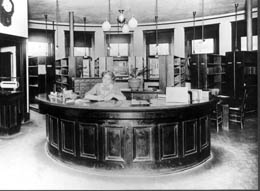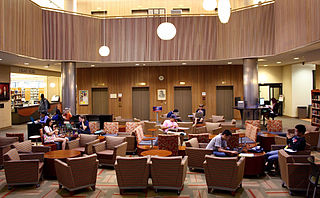
The reference desk or information desk of a library is a public service counter where professional librarians provide library users with direction to library materials, advice on library collections and services, and expertise on multiple kinds of information from multiple sources.

A librarian is a person who works professionally in a library providing access to information, and sometimes social or technical programming, or instruction on information literacy to users.
The Association of College and Research Libraries defines information literacy as a "set of integrated abilities encompassing the reflective discovery of information, the understanding of how information is produced and valued and the use of information in creating new knowledge and participating ethically in communities of learning". In the United Kingdom, the Chartered Institute of Library and Information Professionals' definition also makes reference to knowing both "when" and "why" information is needed.

A hotspot is a physical location where people can obtain Internet access, typically using Wi-Fi technology, via a wireless local-area network (WLAN) using a router connected to an Internet service provider.
Information technology service management (ITSM) are the activities performed by an organization to design, build, deliver, operate and control information technology (IT) services offered to customers.
Digital reference is a service by which a library reference service is conducted online, and the reference transaction is a computer-mediated communication. It is the remote, computer-mediated delivery of reference information provided by library professionals to users who cannot access or do not want face-to-face communication. Virtual reference service is most often an extension of a library's existing reference service program. The word "reference" in this context refers to the task of providing assistance to library users in finding information, answering questions, and otherwise fulfilling users’ information needs. Reference work often but not always involves using reference works, such as dictionaries, encyclopedias, etc. This form of reference work expands reference services from the physical reference desk to a "virtual" reference desk where the patron could be writing from home, work or a variety of other locations.
Michael Gorman is a British-born librarian, library scholar and editor/writer on library issues noted for his traditional views. During his tenure as president of the American Library Association (ALA), he was vocal in his opinions on a range of subjects, notably technology and education. He currently lives in the Chicago area with his wife, Anne Reuland, an academic administrator at Loyola University.
Library 2.0 is a proposed concept for library services that facilitate user contributions and other features of Web 2.0, which includes online services such as OPAC systems. The term "Library 2.0" was coined by Michael Casey in 2006 on his blog Library Crunch.

The following outline is provided as an overview of and topical guide to library and information science:
A reference interview is a conversation between a librarian and a library user, usually at a reference desk, in which the librarian responds to the user's initial explanation of his or her information need by first attempting to clarify that need and then by directing the user to appropriate information resources. Library user's need must be satisfied in any case on Reference interview.

Library circulation or library lending comprises the activities around the lending of library books and other material to users of a lending library. A circulation or lending department is one of the key departments of a library.
Library instruction, also called bibliographic instruction, user education and library orientation, consists of "instructional programs designed to teach library users how to locate the information they need quickly and effectively. [It] usually covers the library's system of organizing materials, the structure of the literature of the field, research methodologies appropriate to the academic discipline, and specific resources and finding tools " It prepares individuals to make immediate and lifelong use of information effectively by teaching the concepts and logic of information access and evaluation, and by fostering information independence and critical thinking. Above all they are aimed at equipping library users with skills to locate library sources and use them effectively to satisfy their information needs.

The William F. Ekstrom Library is the main branch of the University of Louisville Libraries system. Located on the university's Belknap Campus in Louisville, Kentucky, Ekstrom Library contains collections in the humanities, sciences, and social sciences. The University of Louisville Libraries is a member of the Association of Research Libraries (ARL) and, along with Ekstrom, includes libraries for Art, Health Sciences, Law, and Music, as well as the Archives and Special Collections. The University of Louisville Libraries hold approximately 2.2 million print volumes, subscribe to several thousand serials, and provide full-text electronic access to approximately 74,000 journals. Ekstrom is a Federal Depository Library and houses the largest selective government document collection in Kentucky.
With over 17,000 libraries and 2.5 billion materials circulated annually in the United States alone, libraries are a ubiquitous part of the American landscape. However, as libraries modernize, they face an increasingly harsh budget environment, as well as technological disruption in media, scholarship, and education. The political, social, and technological environment is one of transformation and uncertainty.
A pathfinder is a bibliography created to help begin research in a particular topic or subject area.. Pathfinders produced by the Library of Congress are known as "tracer bullets". What is special about a pathfinder is that it only refers to the information in a specific location, i.e. the shelves of a local library.

Learning commons, also known as scholars' commons, information commons or digital commons, are learning spaces, similar to libraries and classrooms that share space for information technology, remote or online education, tutoring, collaboration, content creation, meetings, socialization, playing games and studying. Learning commons are increasingly popular in academic and research libraries, and some public and school libraries have now adopted the model. Architecture, furnishings and physical organization are particularly important to the character of a learning commons, as spaces are often designed to be rearranged by users according to their needs.

The University of Texas at San Antonio Libraries (UTSA Libraries) is the academic library of The University of Texas at San Antonio, a state research university in San Antonio, Texas, United States. UTSA Libraries consists of the John Peace Library (JPL) on the Main Campus, the Downtown Library, and the Applied Engineering and Technology (AET) Library. The libraries provide students and faculty with a comprehensive access to information as well as spaces for active learning, teaching, and interdisciplinary scholarship.
The Digital Visitor and Resident (V&R) model provides a framework to depict how user preference and habit motivates engagement with technology and the web. V&R is commonly described as a continuum, with two modes of online engagement at either end, making a separation between different approaches to engagement. People operating in Visitor mode have a defined goal or task, and select an appropriate online tool to meet their needs as they arise. For example, using a smartphone to search the internet for directions to a local bookstore, thus finding a particular piece of information online and then going offline to complete the task. There will be little in terms of social visibility or trace when online in Visitor mode. People operating in Resident mode are online to connect to, or to be with, other people. For example, posting to the wall in Facebook, tweeting, blogging, or posting comments on blogs. The web supports the projection of their identity and facilitates relationships. In other words, Residents live a percentage of their lives online. Unlike the Visitor mode, there will be online visibility and presence when in Resident mode. It is very common for individuals to engage online in a mixture of Visitor and Resident modes depending on what they are trying to achieve.
Roving is a long and narrow bundle of fiber.

Covenant University Library, also known as Centre for Learning Resources (CLR), is the library of Covenant University in Ota, Ogun State, Nigeria. It is housed in a three-story glass building with a seating capacity of 3,500.







